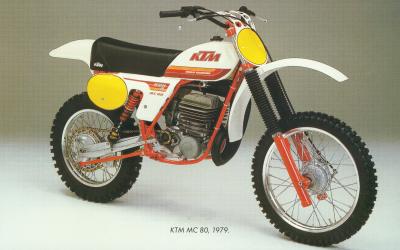
KTM 420 1979/80
KTM 495 1981
KTM 495 1982
KTM 495 1983
KTM 495 1984
KTM 500 1985
KTM 500 1986
KTM 500 1987
KTM 500 1988
KTM 500 1989
KTM production for the next model year would start at the earliest in
late August (08) but usually in early September (09) just after their summer
holiday factory shutdown. So if the frame number at the steering head reads
8208######, 8209#####, 8210#####, 8211#####, 8212#####, 8301##### these would
all be 1983 models meaning they were built from August of 1982 to January
1983 (and so on) as 1983 model year KTM's.
This is true for the mono shockers manufactured from 1982 and up.
For stereo shockers (up to 1982) they used an other system: In the early days they stamped
only the last digit of the year in to the frame: 9=1979, 0=1980, 1= 1981. The two following digits
is the production month: 05=May. So if your frame number starts with 002 ######: It's built in February 1980.
The motor number would also reflect the year of assembly (not the model year sometimes) as 2*563*######, or 3*563*###### this would indicate that the year (2=1982, 3=1983) and the Engine Typ (563=495ccm, 560=420ccm, 561=350ccm and 562=390ccm) of the motor you have. This format is still used on current engine production coding. But beware: only because you have an engine typ 563, it does not mean that you realy have a 495. Because all cylinders without reedvalve from the engine typ 56# (= 350ccm to 495ccm) are interchangable!
Since the engine number doesn't reflect, in every case the size of your engine, it's best to check the spare part number molded on the top right fin of the cylinder head.
In general: If it's a dual plug head, it's in either case a 495! If it has a reed valve intake, it's as well always a 495, manufactured from 1982 to 1984. Note: onto a reed valve based lower end it's not possible to install a cylinder without reed valve.
563.30.006.000: 495ccm, High compression (14:1), dual plug head, from 1981 to 1982, and on US version in 83.
563.30.006.000: 495ccm, High compression (14:1), only one spark plug (same part number, replaces dual plug head)
563.30.006.200: 495ccm, Low compression (11:1), from 1983 to 1984.
560.30.006.000: 420ccm, 1981-1984
560.30.006.100: 420ccm, 1980
561.30.006.000: 350ccm, 1980
562.30.006.000: 390ccm, 1882
1979: The year where everything started: An all new 420ccm, engine typ 560, Called "MC 80". The enduro model called "GS 80" had still the old 400ccm engine
1980: A new GS 420ccm, GS 390ccm and GS 350ccm based on the engine type 560 were introduced that year.
1981: A new MC 495ccm without reeds and other gimmicks, and a water cooled MX 125 was introduced this year.
1982: New MC 495ccm with reed valve. Introduction of the mono shock for all MC-models. MC 250 is still air cooled. All the GS-models are still equiped with stereo shocks.
1983: Introduction of the front disc brake for the 495. MC 250 is water cooled now and has double leading drum brakes. For the GS-models: 350 and 390 were skipped, only GS 420, now with mono shock, is available.
1984: The last air cooled 495, known for low power output but a very strong torque at low rpm. An easy to ride bike equipped with WP-UpSideDown forks and light, powerful double leading drum brakes.

| 1979 Specifications | |
| Bore and stroke | 85 x 74mm |
| Engine type | Two stroke, air cooled |
| Carburator | °40mm Bing |
| Power max. | 52 HP @ 7200 rpm |
| Gearbox | 4 speed |
| Clutch | Wet sintered, 9 plates |
| Ignition | Motoplat |
| Weight | 224 pounds, (102kg) |
| Fork | °38mm telescopic, conventional |
| Fork travel | 11.0" (280mm) |
| Rear shock | Twin WP piggyback or Fox air |
| Rear travel | 11.8" (300mm) |
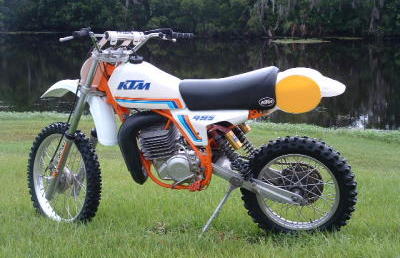
| 1981 Specifications | |
| Bore and stroke | 92.25 x 74mm |
| Engine type | Two stroke, air cooled |
| Carburator | °40mm Bing, PowerJet |
| Power max. | 53 HP @ 7000 rpm |
| Gearbox | 4 speed (5 optional) |
| Clutch | Wet sintered, 9 plates |
| Ignition | Motoplat |
| Weight | 229 pounds, (104kg) |
| Fork | °38mm telescopic, conventional |
| Fork travel | 11.8" (300mm) |
| Rear shock | Twin WP piggyback or Fox air |
| Rear travel | 12.6" (320mm) |
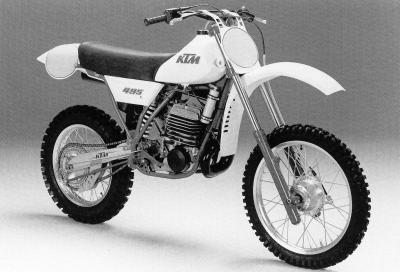
| 1982 Specifications | |
| Bore and stroke | 92.25 x 74mm |
| Engine type | Two stroke, air cooled |
| Carburator | °40mm Bing |
| Power max. | 56 HP @ 6400 rpm |
| Gearbox | 4 speed (5 optional) |
| Clutch | Wet sintered, 9 plates |
| Ignition | Motoplat |
| Weight | 238 pounds, (108kg) |
| Fork | °40mm telescopic, conventional |
| Fork travel | 11.8" (300mm) |
| Rear shock | Pro-Lever WP or Fox multi adj. |
| Rear travel | 13.0" (330mm) |
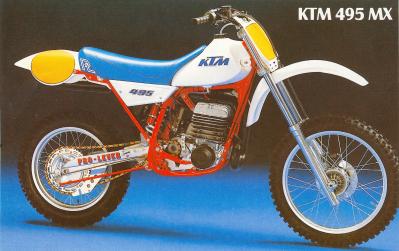
| 1983 Specifications | |
| Bore and stroke | 92.25 x 74mm |
| Engine type | Two stroke, air cooled |
| Carburator | °40mm Bing |
| Power max. | 56 HP @ 6400 rpm |
| Gearbox | 4 speed (5 optional) |
| Clutch | Wet sintered, 9 plates |
| Ignition | Motoplat |
| Weight | 251 pounds, (113kg) |
| Fork | °42mm telescopic, conventional |
| Fork travel | 11.8" (300mm) |
| Rear shock | Pro-Lever WP or Fox multi adj. |
| Rear travel | 13.0" (330mm) |
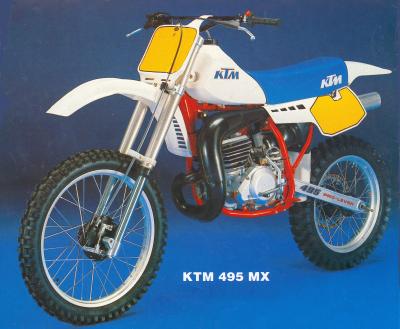
| 1984 Specifications | |
| Bore and stroke | 92.25 x 74mm |
| Engine type | Two stroke, air cooled |
| Carburator | °40mm Bing type 55 |
| Power max. | around 50 HP @ 6400 rpm |
| Gearbox | 4 speed (5 optional) |
| Clutch | Wet sintered, 9 plates |
| Ignition | Motoplat CDI |
| Weight | 231 pounds, (105kg) |
| Fork | WP USD °40mm. |
| Fork travel | 11.8" (300mm) |
| Rear shock | WP Pro-Lever |
| Rear travel | 13.4" (320mm) |
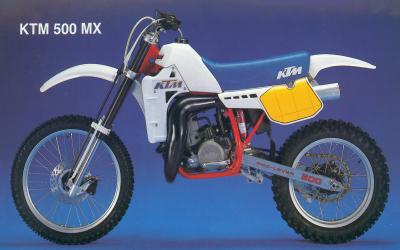
| 1985 Specifications | |
| Bore and stroke | 89 x 78mm |
| Engine type | Two stroke, water cooled |
| Carburator | °38mm type 55 Bing |
| Power max. | 62 HP @ 5900 rpm |
| Gearbox | 4 speed, 5 speed |
| Clutch | Wet sintered, 9 plates |
| Ignition | Motoplat CDI |
| Weight | 218 pounds, (99 kg) |
| Fork | WP USD °40mm. |
| Fork travel | 11.8", (300mm) |
| Rear shock | WP Pro-Lever |
| Rear travel | 13.4" (340mm) |
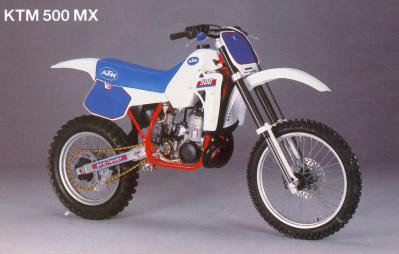
| 1986 Specifications | |
| Bore and stroke | 89 x 78mm |
| Engine type | Two stroke, water cooled |
| Carburator | °38mm type 55 Bing |
| Power max. | 62 HP @ 5900 rpm |
| Gearbox | 4 speed, 5 speed |
| Clutch | Wet sintered, 9 plates |
| Ignition | Motoplat CDI |
| Weight | 220 pounds, (101 kg) |
| Fork | WP USD °40mm |
| Fork travel | 11.8", (300mm) |
| Rear shock | WP Pro-Lever |
| Rear travel | 13.4" (340mm) |
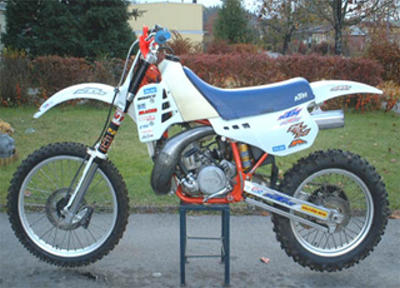
| 1987 Specifications | |
| Bore and stroke | 89 x 78mm |
| Engine type | Two stroke, water cooled |
| Carburator | °38mm type 55 Bing |
| Power max. | 62 HP @ 5900 rpm |
| Gearbox | 4 speed, 5 speed |
| Clutch | Wet sintered, 9 plates |
| Ignition | Motoplat CDI |
| Weight | 227 pounds, (103 kg) |
| Fork | WP USD °40mm |
| Fork travel | 11.8", (300mm) |
| Rear shock | WP Pro-Lever |
| Rear travel | 13.4" (340mm) |
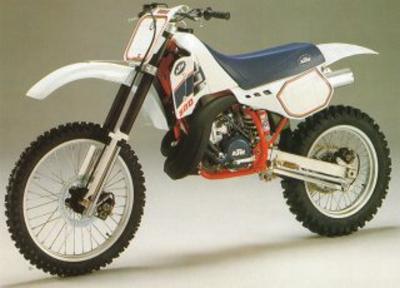
| 1988 Specifications | |
| Bore and stroke | 89 x 78mm |
| Engine type | Two stroke, water cooled |
| Carburator | Dell'Orto VHSB °38mm |
| Power max. | 62 HP @ 5900 rpm |
| Gearbox | 4 speed, 5 speed |
| Clutch | Wet sintered, 9 plates |
| Ignition | Motoplat CDI |
| Weight | 227 pounds, (103 kg) |
| Fork | WP USD °40mm |
| Fork travel | 11.8", (300mm) |
| Rear shock | WP Pro-Lever |
| Rear travel | 13.8" (350mm) |
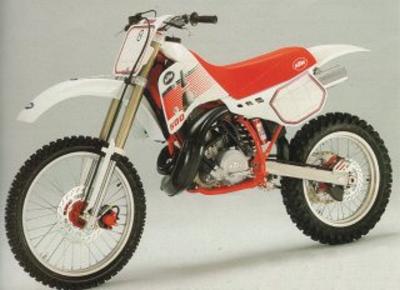
| 1989 Specifications | |
| Bore and stroke | 89 x 80mm |
| Engine type | Two stroke, water cooled |
| Carburator | Dell'Orto VHSB °38mm |
| Power max. | 65 HP @ 5900 rpm |
| Gearbox | 4 speed, 5 speed |
| Clutch | Wet sintered, 9 plates |
| Ignition | Motoplat CDI |
| Weight | 227 pounds, (103 kg) |
| Fork | WP USD °40mm |
| Fork travel | 11.8", (300mm) |
| Rear shock | WP Pro-Lever |
| Rear travel | 13.4" (340mm) |
The production carried into the early 90's. There came a 550 version designed for desert racing. The engine itself lived on as a stroked and bored powerplant in sidecar motocross.